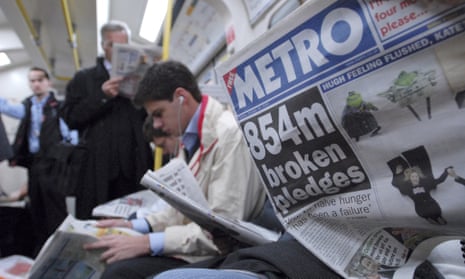I am sitting in a newspaper conference listening to the news editor reciting her list of goodies for tomorrow’s issue: new Brexit controversy, latest Trump shenanigans, ongoing Venezuelan dramas, a hunt for a missing girl, a warning of 70mph gales.
The editor and his team react appropriately: a concerned comment here; a murmur of sympathy there; and the occasional joke.
It is a conference like many others I have attended down the years. Then I realise why my sense of deja vu is so odd. I am witnessing, in this digital era, an exercise in delightfully old-fashioned newsprint journalism at Britain’s most-read national daily newspaper, Metro – the title distributed free every morning in cities across the UK.
It’s as if the online revolution has never happened. That list of news items, carefully harvested by news editor Sarah Getty before the midday news conference, appeared, almost in the form she presented it, in the paper that was read by commuters the following morning.
Metro’s paid-for competitors must ride two horses, continually feeding their websites while devising new angles for their overnight newsprint offerings. By contrast, Metro editor Ted Young and his 50-strong staff are able to concentrate all their attention on the paper. (There is an online Metro presence, but it is run by another division of DMG Media, publisher of the Mail titles.)
Also, unlike most of its rivals, Metro makes a healthy profit based on a simple business model: advertising revenue. “Every issue must turn a profit,” says Young. “There has to be 50% advertising, and that’s how we decide the number of pages we produce.” Profits over the past couple of years have been healthy, running at about £1m a month.
Plenty of free local weeklies have gone to the wall over the past decade due to the pronounced slump in advertising, as Dame Frances Cairncross reported in her review of the industry published last week. But Metro has survived and thrived. Next month, on 16 March, it will celebrate its 20th birthday – a tribute to the man who conceived it, the third Viscount Rothermere, Vere Harmsworth, who died during its development. His son Jonathan, the fourth of the dynasty, kept the faith by overseeing its launch.
According to the latest distribution audit, 1.43m Metros were picked up by people each morning last month, thousands more than the weekday issues of the Sun and the Daily Mail, which rely on high sales on Saturdays to boost their circulation averages. Metro doesn’t do Saturdays, of course.
And that’s a key point: because this is a newspaper that sticks closely to the demands of the market. Most obviously, its editorial formula makes much of being apolitical. News without bias. News to use. News to amuse. Lots of content packed into cleanly designed pages, with few stories longer than 300 words.
There are opinions on offer, not from Young or his staff, but from readers who text or email their comments on the news, and other content, for a page called Talk. An entertainment spread, Guilty Pleasures, run by Andrei Harmsworth (no relation) gets a big show every day. Regular sections on science and technology, travel and fashion are evidently well followed.
There are five reporters who do add value where they can, but Metro is essentially a subeditors’ newspaper. Young, a one-time Sun and Daily Express staffer, has a background in production, as does his deputy, Ruth Baillie, a former production editor of the London Evening Standard, and the night editor, Heather Swain. (Notice, incidentally, the welcome preponderance of female executives.)
In company with their subeditorial team, the trio are responsible for the punning page-one headlines that have become Metro’s hallmark. Among some of the most memorable recent examples, all linked to Brexit, are “Groundhog May”; “PM: I’m Jez saying No”; “Brexican Stand-off”; and the “Lettuce Pray”, over a story about supermarket chiefs’ concern at a fresh food shortage should there be no deal.
Sure, it’s easy to mock Metro for its bland, unchallenging diet of agency news and an over-reliance on celebrity pictures. That said, I note an absence of sleaze – this is not a print equivalent of the sidebar of shame.
There is no investigative journalism. Metro doesn’t hold power to account. It does not serve the people with public interest news, although a case could be made that its coverage of the main events of the day is informative in itself, and all information has value. But the figures suggest that bite-sized news does have an enthusiastic audience. No one is forced to pick up copies from the container bins at stations and on buses throughout the land.
Maybe the “dwell time” on each story is less than a minute. Maybe many readers are through the whole paper in five minutes. Maybe they turn straight to the puzzle page and sit doing the crossword. Even so, as Young says, people are aware of what they’re going to get and, given its unbiased political agenda, they enjoy its impartiality. Unlike online, he stresses: “We don’t touch fake news so people can trust us.” He sees the result by observing readers thumbing through his Metro while he travels each morning by tube from his home in Richmond, south-west London, to the paper’s Kensington office.
Since his appointment in 2014, Young has steadied a ship that seemed, for a time, to be wobbly. He takes every opportunity to point out, whenever commentators such as me suggest newsprint is in its death throes, that his paper is bucking the trend.
Will Metro last another 20 years? Advertisers, rather than readers, will decide its fate. There is no denying that, as far as the publishing company is concerned, it exists for only one reason: to turn a profit. At present, advertisers like it because the core readership, with an average age of 39, is far younger than that of the popular paid-for titles. So, while there is enough advertising to support it, Metro – and its puns – will go on and on.

